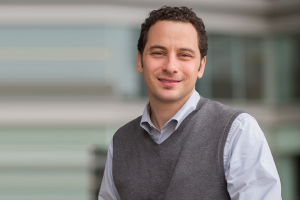Selfie-powered skin cancer awareness

UNC Hussman School of Journalism and Media Professor Seth Noar led a team of researchers who analyzed the increase in skin cancer awareness generated by a single viral Facebook post.
The new study, spearheaded by Noar, shows just how effective one person can be in generating awareness, and asks how public health researchers might tap into similarly personal stories to reach more people.
When she was 27 years old, Tawny Dzierzek, a nurse from Kentucky, shared a post on Facebook after a recent skin cancer treatment. The accompanying selfie graphically illustrated her blistered face. Dzierzek’s past included heavy tanning bed use, and she’d been diagnosed with skin cancer six years earlier. Her post was shared 50,000 times on social media in less than a month, and her story was picked up by a variety of media outlets.
Researchers led by Noar recently reported in the journal Preventive Medicine that Google searches about skin cancer reached near-record levels during the timeframe when media coverage about Dzierzek’s selfie was at its peak.
“A growing body of research shows that stories can be very impactful — more impactful than didactic information — in delivering a health message,” said Noar.
Noar collaborated with several colleagues across the country with expertise in digital surveillance methods. The team evaluated Facebook shares and media coverage, as well as trends in online Google searches for the words “skin” and “cancer” from the date of Dzierzek’s Facebook post (April 25, 2015) through the period when media coverage of her story peaked and then declined.
The team found that all search queries for skin cancer reached near-record levels, increasing 162 percent compared with historical trends on May 13, 2015, and 155 percent on May 14, 2015, when news about Dzierzek’s skin cancer “selfie” was at its peak. Queries remained higher through May 17.
“In practical terms, this translated into about 200,000 more Google searches than would otherwise have been expected in just those six days,” said study co-author John Ayers of San Diego State University. In addition, online searches for skin cancer prevention were as much as 232 percent higher than expected, while queries about skin cancer and tanning were as much as 489 percent higher.
Ayers added that if public health researchers and advocacy groups could get better at identifying these social media events in real time, they could help amplify the message and reach many more people.
“When this happened, it really captured the public’s attention on social media and through national media coverage,” Noar said. “That’s an opportune time for all of us to get the message out about the dangers of tanning beds.”
Interest in the report’s findings is garnering renewed media traction for the message that tanning beds are a health hazard.
In addition to Noar and Ayers, the study’s other authors are Eric Leas of Stanford University School of Medicine; Benjamin Althouse of the Institute for Disease Modeling, Bellevue, Washington; Mark Dredze of Johns Hopkins University; and Dannielle Kelley, who received her PhD from the Hussman School and is now a Cancer Prevention Fellow at the National Cancer Institute.